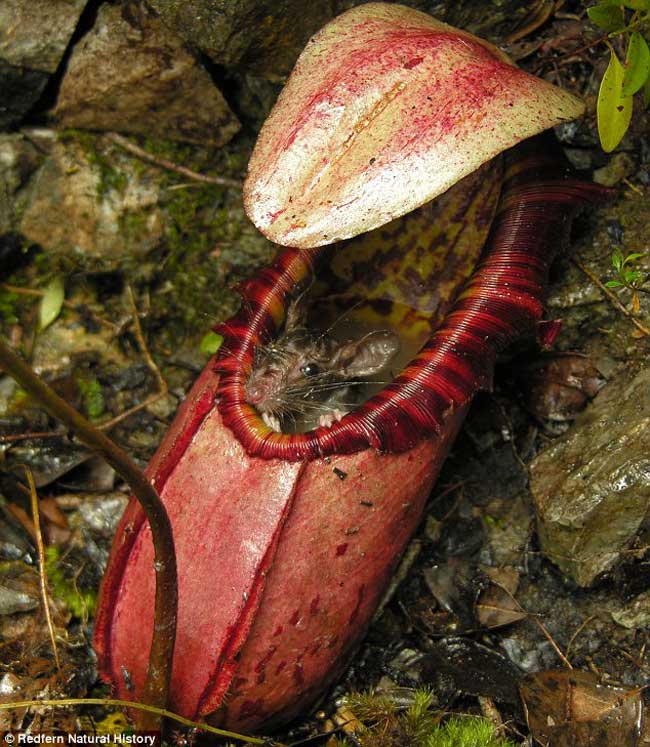Pitcher plants attract insects by secreting an attractive nectar along the lip of the pitcher-shaped leaf. Why does a plant eat insects.
 Giant Plant Eats Rodents Live Science
Giant Plant Eats Rodents Live Science
However it traps and eats insects to meet its requirements for certain nutrients that are not present in the environment where it grows.

Why pitcher plant eat insects. Pitcher Plant carnivorous insectivorous plant carries out photosynthesis. Inside The Stomach Of A Carnivorous Plant. The insect cannot get out of the cup because the.
The nectar attracts insects. Why have some plants evolved to eat insects. He and his lab will soon run experiments to.
Pitcher plants catch get insects in a cup of liquid. The pitfall is made from specially-adapted leaves which often form a long tubular structure. Ghatparni plant is found in Meghalaya Indonesia and Australia.
Givnish thinks thats because carnivory ultimately boosts photosynthesis abilities a skill plants deploy best in bright and wet conditions. To fulfill their nitrogenous need they need to eat insects. The pitcher plant is then able to absorb the nutrients from the dead bug.
Similar to carnivorous plants like the Pitcher Plant the Sundew attracts insects with a sweet-smelling nectar that lures them to the plant and to their eventual demise. The leaves often become dry and crisp and you may notice tiny sticky black spots. Dissecting a Tropical Nepenthes Pitcher Plant - YouTube.
This plant eats rats frogs and oth. The apex of the leaf is the lid. It breaks down the insect and absorbs the nutrients.
Plants living in marshy areas do not get nitrogen from the soil. The walls of the cup make nectar sweet liquid. Carnivorous plants get nitrogen from the insects they eat.
Thrips Tiny thrips are hard to see but they create havoc when they suck the juices from pitcher plants. Sticky traps are one non-toxic option. Find an answer to your question Why does a pitcher plant eat insects when it is capable of carrying out photosynthesis.
Instead they secrete a sticky substance called mucilage on its leaves that traps the insects and then when it senses. Dissecting a Tropical Nepenthes Pitcher Plant. Insect-eating plants also tend to thrive in sunny and moist habitats.
Inside The Stomach Of A Carnivorous Plant. Some gardeners have good luck with systemic insecticides but again use chemicals with extreme care. Pitcher of the pitcher plant is actually a modified leaf.
The plant absorbs these proteins breaks them and synthesise the protiens it needs for its own growth. To fulfill their nitrogenous needs they need to eat insects. Pitcher plant is the example of an insectivorous plant.
The plant absorbs these proteins breaks them and synthesise the protiens it needs for its own growth. Once the insect gets inside the plant sarracenia produces digestive juices through the walls. In a pitcher plant the leaf is modified into a pitcher like structure.
But pitcher plant eats insects because it grows in swamps or bog areas where the soil is deficient in nitrogen mineral. The soil of marshy land is deficient in nitrogen. Plants living in marshy areas do not get nitrogen from the soil.
The pitcher is complete with a lid. The Pitcher Plant is a passive predator that captures insects using a pitfall trap. Thats why they need another source to meet their need.
Pitcher plants and other insect eating plants grow on soils which are deficient in nitrogen. When an insect lands on the wall it falls down into the liquid. This source is the proteins that are in the insects body.
Though there are different types of pitcher plants theyll often capture insects in similar fashions. They are found in a wide range of habitats and like the Venus Fly Trap use their carnivorous adaptations to compensate for nutrient-poor soil. This source is the proteins that are in the insects body.
Plants that eat insects are called insectivorous plants. The inside of pitcher is full of hair-like. The plants essentially get nitrogen from the insects.
Pitcher plants digest insects with the help of digestive enzymes. They trap and digest insects. So just to fulfill its nitrogen requirement it traps the insects and utilize their proteins.
Thats why they need another source to meet their need. For this reason it is called insectivorous plant. The plant evolved because it has found that eating small insects could give it the necessary Proteins Nitrogen and other minerals that it couldnt just seep from the soil.
Write a brief note on pitcher plants. Insect Eating Plants Facts Why Nepenthes Eat Insects. When the bug attempts to eat this nectar it falls into a liquid pool at the bottom of the leaf trap where it drowns.
Scientists studied the genome of a strain of the pitcher plant to answer the questionSubscribe to Vocativ. Pitcher plants and other insect eating plants grow on soils which are deficient in nitrogen. Unlike the Pitcher Plant theres no internal aspect for the insects to be digested in.
Popular Posts
-
This is a list of the 100 most populous counties in the United States based on the national decennial US census conducted on April 1 2010 an...
-
Population identify as Native American or Alaska Native with 44 identifying as at least one other race according to 2010 Census Bureau data ...
-
He ruled from 5 April 1462 to 27 October 1505 he was known as Ivan the Great and was a Grand Prince of Moscow. 29 October 1603 Moscow Russia...
Featured Post
eyes but cannot see verse
83 Bible Verses about Have Eyes But Do Not See . “Son of man, you dwell in the midst of a rebellious house, who have eyes to see, but ...

ads
